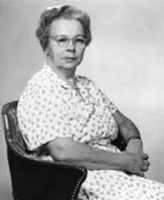










American physicist Katharine Burr Blodgett (1898–1979), the first woman scientist ever hired by General Electric, is credited as the inventor of non-reflective glass. She spent her entire career with General Electric, where through her work she made significant contributions to the field of industrial chemistry. Blodgett's invention of invisible non-reflective glass went on to find utility in the nascent photographic, optics, and automotive industries. She was also the first woman to earn a Ph.D. in physics from England's Cambridge University.
A Worldly Education
Blodgett was born on January 10, 1898, in Schenectady, New York. Her mother was Katharine Buchanan Blodgett; her father, patent attorney George Bedington Blodgett, was director of the patent department at General Electric's Schenectady-based research facility. He died several weeks before young Katharine was born, leaving his widow with a young son and the newborn Katharine.
The grieving family moved to New York where Mrs. Blodgett hoped to find more opportunity than in a small town. After three years, she moved her family to France and then to Germany, because she wanted her children to learn languages while they were young. The family then returned to the United States, where Katharine started school at the age of eight. She attended a public school in Saranac Lake, New York, for one year before entering the exclusive Rayson School in New York City. There she learned precise English speaking patterns and excelled in science.
Upon completing her studies at Rayson, Blodgett earned a scholarship to Bryn Mawr, where she studied under mathematician Dr. Charlotte Scott and physicist Dr. James Barnes. It was while at Bryn Mawr that Blodgett was inspired to pursue a career in science. During the early 20th century the most logical career for women interested in science was teaching, but Blodgett wanted a greater challenge. She hoped the increased job opportunities for women as a result of the World War I labor shortage would benefit her.
Found Mentor in Irving Langmuir
At the age of 18, Blodgett visited the General Electric research laboratories where her father had worked. She met the laboratory's assistant director, Irving Langmuir, a distinguished physicist who was impressed by Blodgett's interest and intellect. He gave the young woman a tour of the lab and advised her that she would find greater job opportunities with General Electric if she obtained a master's degree in physics.
Blodgett obtained her master's degree in physics from the University of Chicago in 1918. It took her only one year to complete the postgraduate work. Her master's thesis was on the chemical structure of gas masks—a timely topic during World War I.
Langmuir came through with his promise of employment, and when Blodgett returned to Schenectady at the age of 20, she became the first woman research scientist at the General Electric laboratories. Though she never knew her father, she worked in the same facility he once had and met many of his former colleagues. As Langmuir's assistant, she gained the advice of a valuable mentor. Langmuir had been working at General Electric since 1909. His early work included research on vacuum pumps and light bulbs and resulted in many patents in his name. In 1932 he would be awarded the Nobel Prize in chemistry. Blodgett collaborated with him on many projects leading up to this award.
During her first six years at the General Electric labs, Blodgett assisted Langmuir on projects related to electric current flow under restricted conditions. The two scientists published many papers on the subject in scientific journals. Blodgett excelled at communication and she became known for her clear presentation of scientific ideas.
Earned Ph.D. from Cambridge University
Langmuir encouraged Blodgett to continue her education in order to advance her career and in 1924 was able to get his protégé into the Cavendish Laboratory at Cambridge University in England. Cavendish was an exclusive laboratory, and it was only through Langmuir's influence that administrators allowed a woman to study there. Blodgett studied under world-renowned physicists, including Nobel Prize winner Sir Ernest Rutherford. In 1926 she became the first woman to earn a Ph.D. in physics from Cambridge University.
When Blodgett returned to the General Electric labs in Schenectady, she became a member of Langmuir's core research group. She worked on perfecting tungsten filaments in electric light bulbs. Later Langmuir assigned her to work on surface chemistry. Langmuir had previously discovered that oily substances form a one-molecule thin surface film when added to water. He asked Blodgett to find an application for this phenomenon.
Blodgett found that when she dipped a metal plate in water containing oil, the oily substance formed a layer on it, as it did on the water's surface. She inserted the plate into the water repeatedly and found that additional molecular layers formed. Each layer exhibited a different color, and these colors could be used to gauge the thickness of the coating. From these experiments, Blodgett invented a gauge for measuring the thickness of film within one micro-inch. General Electric marketed her color gauge for use by physicists, chemists, and metallurgists. It was simple, accurate, and more affordable than that attainable through existing instruments. Blodgett and Langmuir published a paper on depositing successive monomolecular layers of stearic acid on glass in the February 1935 Journal of the American Chemical Society. Two additional papers on the topic followed.
Garvan–Olin Medal